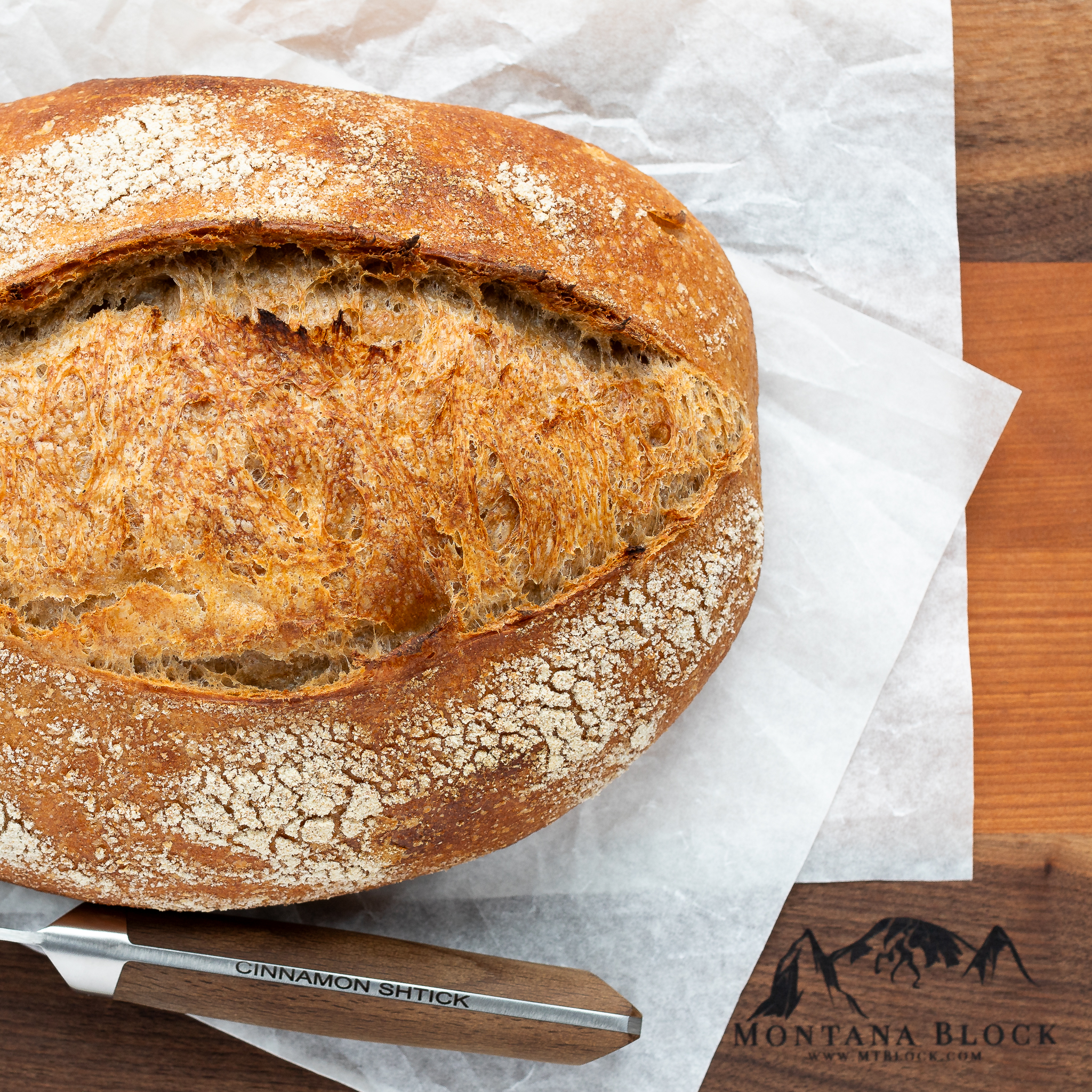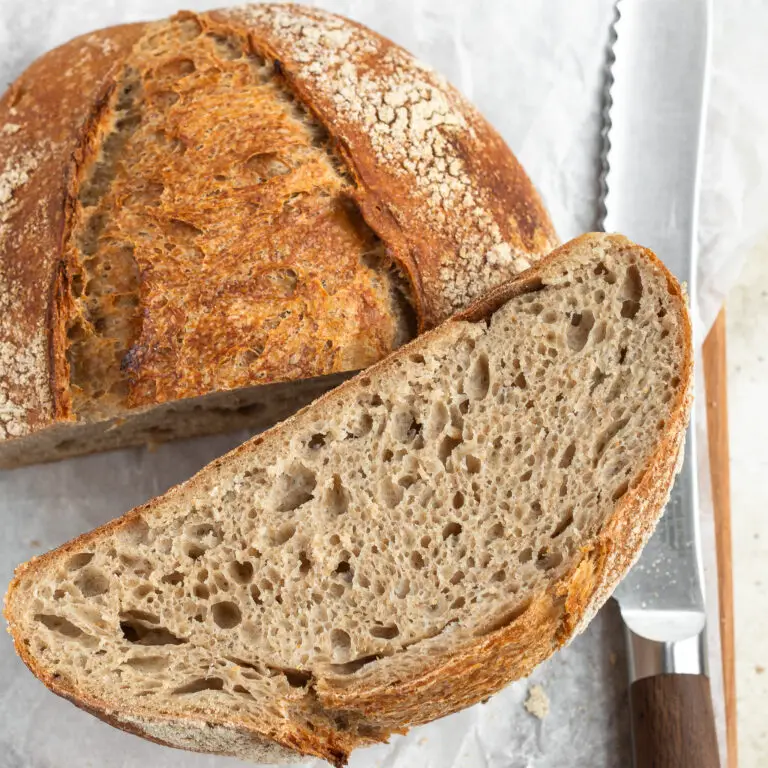This post may contain affiliate links. As an Amazon Associate, I earn from qualifying purchases. For more information, please visit my Privacy Policy.
This Spelt, Whole Wheat and Rye Sourdough has become one of my favorite sourdough breads to make. It’s adapted from a recipe a friend shared with me. I added the rye to it, which advances the flavor profile beautifully. I also played around with the levain so that I do not need much ripe starter, and the timing works out better for my schedule.
Ingredients for Spelt, Whole Wheat and Rye Sourdough
Most of the ingredients for this easy Spelt, Whole Wheat and Rye Sourdough bread are in the title. But let’s dive in a bit:
- Ripe starter. I feed my starter around 10:30 in the morning, and I mix the levain with it around 10:30 pm. It is usually just passed its peak at this point, which works out great for this bread. The room temperature in my kitchen is usually around or above 74° F. If you are new to sourdough and feeding your starter, check out my Sourdough Starter Guide.
- All purpose flour. I use King Arthur all purpose flour. At 11.7% protein, I like how it performs in this bread with the whole grains. I have used bread flour (which has a higher protein content) in its place, but I feel the bread comes out a bit gummy.
- Water. Temperature, temperature, temperature. It matters. Use water at the proper temperature. (See below for more on this important topic!) For those of you into hydration facts, this loaf is 82% hydration.
- Spelt flour. I have used various brands of spelt flour, including Farmer Ground (which is at my local Whole Foods), Arrowhead Mills, and Bob’s Red Mill. They have all performed great in this recipe.
- Whole Wheat flour. I use either King Arthur or Whole Foods own brand (which is from Central Milling).
- Rye flour. My favorite rye flour is King Arthur’s classic medium rye. I have also used, with great success, other brands such as Bob’s Red Mill.
- Salt. The key to success for any bread. Fine sea salt is best here. I use Morton’s fine sea salt.

How to Make the Best Sourdough Bread
These are my tips for a successful Spelt, Whole Wheat and Rye Sourdough, and for making any basic sourdough recipe.
Know Your Starter
Because the levain is built up slowly overnight, this recipe works great if your starter is just passed its peak when you mix the levain. I generally keep my starter on my kitchen counter, which is usually approximately 74° F. If your kitchen is colder, it may take some additional time for it be ready in the morning when you mix the dough. However, if your kitchen is warmer, the levain may be ready sooner in the morning. Get to know your starter and how it behaves in your environment.
Calculate the Correct Water Temperature
Water temperature is so important. Many sourdough bakers ignore this important fact. When I feed my starter and build the levain, I use water that is at approximately 73° F. However, when I mix the water with the flour in the morning to autolyse, I calculate the correct temperature by doing this:
Fermentation Temperature Times 4
Multiply the temperature at which you will bulk ferment by 4. So, for this recipe, the ideal temperature is 78° F. 78 x 4 = 312.
Subtract Flour Temperature
From the 312, subtract the temperature of the flour. Literally stick your thermometer into the flour to determine the precise temperature. (Tip: I usually weigh out and mix the flours into a large mixing bowl the night before, when I mix the levain. I cover the bowl of flours with plastic wrap so it is ready for me in the morning to take its temperature and then mix the water into it to autolyse.) Let’s assume your flour is 74° F.
Subtract Levain Temperature
Subtract the temperature of your levain. Again, literally stick your thermometer into the center of your levain. Let’s assume it is also 74° F.
Subtract Bulk Fermentation Temperature
Subtract the temperature of where bulk fermentation will occur. If this is my countertop, it may also be 74° F. However, I usually use my Brod & Taylor proofer, so I can set the temperature directly at 78° F. (My own opinion: I LOVE this proofer. It has made bulk fermentation so much easier and so much more consistent.) For purposes of this example, let’s assume we are using a proofer and the temperature is set at 78° F.
Subtract Friction Temperature
Subtract 6, which represents a reasonable estimate of the degrees of heat added into the dough from the friction when you mix and knead it.
Calculation
Based on these numbers, we have 312 – 74 – 74 – 78 – 6 = 80° F.
That means that, when we pour the water into the flours in the morning to autolyse, we should heat the water up to 80° F.
Use Wet Hands
The dough for this Spelt, Whole Wheat and Rye Sourdough can be a bit sticky, mostly due to the rye flour and its high hydration. I find rye to be a bit “difficult” to work with for this reason. So, when handling or kneading the dough, wet your hands and flick off any excess. Having moist hands will prevent the dough from sticking to them. Do this as many times as necessary, but be sure not to use soaking wet hands so you can avoid adding too much additional water into the dough. If you find the dough too wet to work with the first time, try reducing the first amount of water when autolysing to 280 grams instead of 300 grams.
Another incredibly cheap and useful tool is a bowl scraper. Just like wetting your hands, wet the bowl scraper and use it to scrape down the sides of the bowl.
Use the Slap and Fold Technique
For this recipe, I like to first knead the dough in the bowl for a bit. Then I like to do several minutes or even five minutes of slap and folds, meaning slapping the bowl on the countertop, folding it, lifting it and slapping it again. This method helps develop the gluten and for the dough to absorb more of the water. Is it necessary for this recipe? No, but I do find it helpful. I demonstrate this in the video that accompanies this post.
Flour the Banneton
If you are artistic (I am not!) and like to score gorgeous designs on your bread, you should probably dust your banneton with just white rice flour. I prefer a mixture of 50% white rice flour with 50% rye flour, plus a small handful of wheat bran. That mixture prevents the dough from sticking to the banneton, and it helps create a darker, more flavorful crust.

Recommended Schedule:
Day 1, morning: Feed your starter as usual
Day 1, 10:00 p.m.: Stir the levain ingredients.
Day 2: 9:00 a.m.: Autolyse flours with water.
Day 2: 10:00 a.m.: Mix dough; bulk ferment for 3½ hours; refrigerate overnight.
Day 3 or 4: Whenever you want to bake, preheat Dutch oven for 45 minutes and bake.
Other Sourdough Recipes
Be sure to check out my other sourdough and sourdough discard recipes:
- Sourdough Focaccia
- Semolina Spelt Sourdough
- Lemon Blueberry Sourdough
- Lemon Poppyseed Sourdough Pullman Bread
- Vegan Cinnamon Raisin Sourdough Bread
- Fluffy Sourdough Challah
- Sourdough Discard Garlic Knots
- Sourdough Discard Sandwich Bread
- Sourdough Discard Pizza
- Sourdough Discard Pretzels
- Sourdough Discard Cinnamon Sugar Pretzels
- Sourdough Chocolate Chip Cookies
- Sourdough Blueberry Muffins
Frequently Asked Questions About Making Spelt, Whole Wheat and Rye Sourdough
Why is my sourdough dough so sticky?
This recipe is high hydration, which means it is wetter and therefore stickier to work with. In addition, rye flour contributes to the stickiness. To avoid the dough sticking too much to your hands, moisten your hands with water before touching the dough.
How important is water temperature for sourdough?
Water temperature is extremely important when mixing sourdough. Be sure to use water at the correct temperature. If the desired bulk fermentation temperature is 78° F, multiply 78 by 4 to get 312. From 312, subtract the temperature of the flour, the temperature of the starter, the temperature of where the dough will bulk ferment, and the number 6 (which represents the degrees of heat added from the friction of mixing and kneading). The result is the desired water temperature.

Spelt, Whole Wheat and Rye Sourdough
Ingredients
Levain
- 12 grams ripe starter
- 36 grams water
- 36 grams all purpose flour
Dough
- 230 grams all purpose flour
- 65 grams spelt flour
- 65 grams whole wheat flour
- 40 grams rye flour
- 300 grams water 1
- 84 grams levain
- 10 grams fine sea salt
- 20 grams water 2
Dusting Flour
- 20 grams white rice flour
- 20 grams rye flour
- 1½ teaspoons wheat bran
Instructions
Day 1: Mix Levain
- Before you go to bed, mix the levain ingredients. Cover with plastic wrap and prick 4-5 holes with a toothpick in the plastic wrap to allow some air to flow. (Or just cover the bowl loosely as you normally do when you feed your starter.) Leave the levain to rest at warm room temperature, about 74° F for 12 hours.
Day 2: Mix and Bulk Ferment Dough
- In a large bowl, combine the flours and water 1 (300 grams) at the correct temperature. (See water temperature explanation in above post and in below notes.) Mix just until the water is absorbed by the flour. Cover with plastic wrap and allow to rest for 1 hour.
- Add the starter and a splash of water 2 (splash of the 20 grams) and mix in using a Danish dough whisk or your wet hands until fully combined. Cover the dough and allow to rest for 10 minutes.
- Sprinkle the salt over the top and drizzle the remaining water 2 over the top. Dimple the salt and water in with your hands, using a clawing motion, until fully combined. Knead the dough in the bowl, folding the dough and using your fist to punch it into the rest of the dough, constantly rotating the bowl, until the dough is not very sticky and uniform. If it is sticky, keep your hands lightly wet while kneading. You can also do several minutes of slap and folds on the countertop.
- Bulk ferment for 3½ hours, during which time do three sets of four folds after the 60, 90 and 120 minute marks.
- On a lightly floured surface, pre-shape the dough and allow it to rest, uncovered, for 30 minutes.
- Dust your banneton with dusting flour mixture.
- Shape the dough, making sure to create tension on the outside of the dough. Place the dough into the prepared banneton. Dust some all purpose flour on the top and allow to rest for 20 minutes.
- Wrap the banneton in plastic wrap and refrigerate it overnight for 12-18 hours.
Day 3 (or 4): Bake
- In the morning, place a Dutch oven in the oven and preheat it 450° F. Move the banneton, still wrapped in plastic wrap, from the refrigerator to the freezer for 45 minutes.
- Remove the plastic and place a piece of parchment paper over the banneton. Place a cutting board on top of the parchment paper. Flip it over and lift up the banneton.
- Score the dough as desired. Remove the Dutch oven from the oven, uncover it, and carefully slide the parchment into the hot Dutch oven. Spray water all over the bread or add 3-4 ice cubes and immediately cover the Dutch oven. Bake for 20 minutes. Remove the Dutch oven lid and bake an additional 30-35 minutes. Allow the bread to cool to room temperature before slicing.


6 Comments
This looks like an awesome bread! Can’t wait to make it this weekend and enjoy it for breakfast! Thanks!
I love any type of bread. I had never tried a combination of spelt, whole-wheat and rye in sourdough. My whole family loved it. Great recipe, worked out well.
Your instructions for this recipe are so thorough and helpful! This is such a great bread recipe!
Sounds wonderful. Any chance you have a similar recipe made with yeast??
Sorry, I do not.
Your spelt, whole wheat, and rye sourdough looks absolutely divine! 😍 I can almost smell the earthy aroma through the screen! Can’t wait to give this recipe a try and elevate my bread game! 🍞🌾